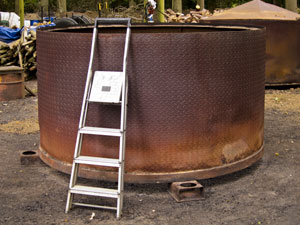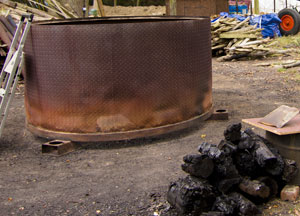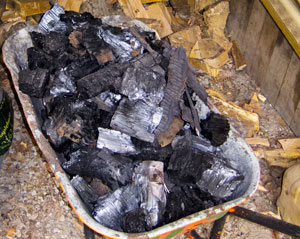Biochar and biofuels

Broadly speaking, Biochar is charcoal that is not used for heating, barbecues or blacksmithing. It is charcoal that is (often) used for soil improvement and carbon sequestration.
Charcoal is created by pyrolysis – that is, the incomplete burning of wood or biomass when oxygen /air is restricted. Typically, full-time charcoal producers have a large, steel kiln* about three metres in diameter and over a metre in height. This is loaded up with wood, mostly hardwoods such as oak, which have a very slow burn. The kiln is then sealed with a large lid. To make charcoal, the burn must be slow and incomplete so that the wood dries out and its structure and capacity for burning remains. This process – converting wood to charcoal – takes some 14-16 hours and produces ready-to-use lumps of charcoal. To watch the process of charcoal making, visit woodlands TV.
 Adding charcoal to soil can improve its structure (tilth), water retention, reduce the leaching of minerals and acidity, help with drainage, improve mineral take up by plants. There has also been the suggestion that adding biochar to soils can reduce greenhouse gas emissions from the soil – specifically carbon dioxide, methane and nitrous oxide.
Adding charcoal to soil can improve its structure (tilth), water retention, reduce the leaching of minerals and acidity, help with drainage, improve mineral take up by plants. There has also been the suggestion that adding biochar to soils can reduce greenhouse gas emissions from the soil – specifically carbon dioxide, methane and nitrous oxide.
The NERC’s Centre for Ecology and Hydrology is now investigating the use of charcoal on land used to grow bioenergy crops (such as Miscanthus – a tough perennial grass or coppiced willow). A recent paper published by Sean Case et al talks about the benefits of using biochar in association with these energy crops. It would appear that :
- The addition of biochar to soil before planting energy crops can cut soil emissions by one third – specifically CO2 emissions. Though this effect has been seen previously in the lab – this study followed carbon emissions over a longer period in the field.
- The biochar appears to change the microbial activity in the soil – so that there is less ‘soil respiration’
- The biochar also reduces the conversion of N based fertiliser to nitrous oxide
- The biochar adds carbon to the soil, and the use of willow / Miscanthus means that the soil is not churned up by ploughing each year and the carbon is not disturbed.
 All of the above add to the sustainability benefits of bioenergy crops.
All of the above add to the sustainability benefits of bioenergy crops.
New techniques of pyrolysis are becoming available which not only produce charcoal but also liquid or gas fuel – the latter can be use to generate power, and the charcoal added to soil : so that the harvested material yields multiple benefits. In the longer term, it is possible that biochar will not be made from wood but perhaps municipal waste or even chicken manure – according to Dr Jeanette Whitaker (co-author of the paper).
The Centre for Ecology and Hydrology is working on a number of interesting projects associated with bio-energy crops, biofuels and sustainability issues – see http://www.ceh.ac.uk/sci_programmes/bioenergy-crops.html for further information.
Comments are closed for this post.

If you have the time ( and energy ) have a read of
http://www.blackmountainwoodfuels.co.uk/localResources.html
related – sort of –
mart
23 April, 2013